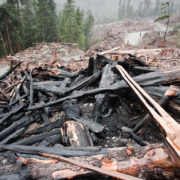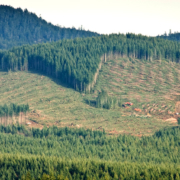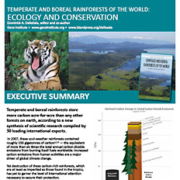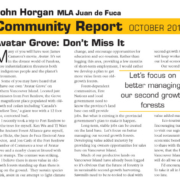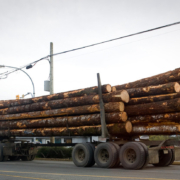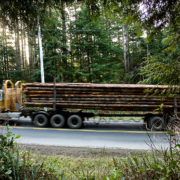Certification fails to protect B.C. forests
/in News Coverage/by TJ WattIn response to increasing public outcries over his complete mismanagement of forests in the public interest, Forest Minister Pat Bell is frequently taking refuge behind forest certification programs. But are third-party stamps of approval really, as Bell claims, a guarantee that our forests — a trillion-dollar publicly owned asset — are being managed sustainably?
To date, some 54 million hectares (98 per cent) of British Columbia’s Crown forestland have been certified by one of three bodies.
Two industry-funded programs — the Canadian Standards Association and Sustainable Forest Initiative — between them account for 51.5 million hectares, while the third, more autonomous Forest Stewardship Council’s (FSC) certifications apply to 2.6 million hectares.
Companies seek certification for obvious reasons. It provides them with marketing eco-labels for buyers who might otherwise boycott their products if not assured that the wood comes from sustainably managed forests.
All three certification bodies purport to assure foreign markets that forest practices are regulated and the laws obeyed.
But what does this actually mean? Certification is only as good as the laws, regulations and operating policies governing forest use in B.C. After a decade of deregulation of forest management, legislation has been rendered weak, timber-centric and ineffective at protecting other forest values.
All three programs also suggest that B.C.’s forestlands are actively managed, with a strong, consistent role played by the provincial Forest Service and in particular B.C.’s chief forester. As well, the certifiers claim that the province’s wealth of biological diversity is conserved.
But dig just a little into such claims and questions soon arise.
First, forest companies annually cut about one per cent of forestland for which they are legally held responsible to replant or reforest.
This leaves government responsible for the lion’s share of forest management on almost all Crown forestland. Some 70 management units cover the forested area of B.C. of which 37 are timber supply areas (TSAs) and 33 are tree farm licences (TFLs). Yet not one government-managed TSA currently has even a forest management plan.
Second, B.C.’s chief forester, who is responsible for setting sustainable logging rates in all 70 management units every five years, uses a forest inventory that is outdated, incomplete, unreliable and grossly underfunded, and for which Bell and his cabinet colleagues must take responsibility due to their continued cutting of forest management staff (1,006 in the past decade) and budgets.
Third, on the biological diversity front, an inadequate patchwork of laws and policies has, according to the David Suzuki Foundation, placed more than 1,900 (43 per cent) of the province’s 4,373 species at risk of extinction or extirpation, leaving B.C. one of the few jurisdictions in Canada without stand-alone legislation to protect biodiversity.
If any doubt remains about Bell’s assertion that certification ensures sound forest management, consider as well that all three certification bodies accept a system of forest management in B.C. that relies completely on:
– A computer model, largely unverified beyond research plots, of how trees grow and how much timber they will yield over time that doesn’t adequately take into account that trees die naturally, even in “healthy” plantations;
– Little or no midterm monitoring to see how many planted or reforested trees have survived and are yielding the timber they are projected to (Note: FSC does require monitoring); and
– An outdated forest inventory that fails to report properly the extent of forestland in the province insufficiently stocked with trees following logging activities, forest fires or insect attacks — an area that may now amount to nine million hectares, or three Vancouver Islands in size.
In short, we have a poor handle on what is in our forest warehouse and at the worst of times — as if we were Future Shop on the eve of Boxing Day, with no clear idea of how many computers and widescreen TVs we had in stock. Take another box store, Ikea, and ask why it doesn’t buy B.C. forest products.
With wholly inadequate forest health monitoring in light of climate change, a disbanded forest research branch, a pathetic tree-planting program (relative to the area of insufficiently reforested land), a negligible stand-tending program, one remaining growth-and-yield forester for the province, and a forest inventory program in name only, on what basis do the three certification bodies assure foreign buyers of our forest products that B.C.’s forests are sustainably managed?
And how much longer can Bell keep up the pretence that “we have some of the best forest practices in the world”? That claim might have held true for the last decade of the last century, but today it has become a hollow echo from the past in the dark tunnel of deceit.
So what are the leadership candidates’ positions — both B.C. Liberal and New Democrat — on forestry and the environment, and how will they restore the public interest to both files and put the supernatural back into British Columbia?
Anthony Britneff recently retired from a 39-year career with the B.C. Forest Service where he held senior positions in the inventory, silviculture and forest health programs.
Link to original article: https://www.vancouversun.com/technology/Certification+fails+protect+forests/4001831/story.html#ixzz1A8crfyqM

